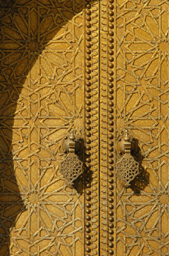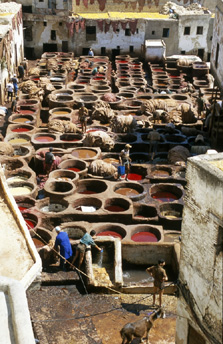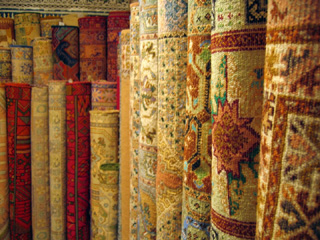1902 Encyclopedia > Fez, Morocco
Fez, Morocco
FEZ, one of the chief cities in the empire of Morocco, into which kingdom it was incorporated in the year 1548. It is situated in 34° 6´ 3" N. lat. and 4° 58' 15" W. long., being about 197 miles N.E. of Morocco, 100 miles E. from the Atlantic, and 85 miles S. of the Mediterranean.
The city is beautifully situated on the slopes of a pearshaped valley, through which flows the Wad-el-Jubar (or River of Pearls). The stream is fordable throughout, and is an affluent of the Wad-el-Sebu, which it joins about six miles to the north of the town. The Wad-el-Jubar divides the city into two quarters the ancient town (Fas-el-bali) on the right bank, and the new (Fas-el-dyedid) on the left.

Detail from Golden Gate, Royal Palace, Fez, Morocco
Like many Oriental cities, Fez from a distance is a peculiarly striking looking place. It stretches out between low hills, crowned by the ruins of ancient fortresses ; and from the turreted walls stand out in bold relief countless domes, minarets, and flat-roofed houses. The old battlemented wall, which still surrounds the place, though falling into decay, is yet flanked by strong masonry towers. The surrounding country is well cultivated. In some places the view is marvellous. The whole neighbourhood seems covered with ruined building of every sort, - cells of reclauses, broken columns, massive stone aqueducts, dome like tombs, dilapidated forts, and ruined houses. Except on the south side the city is surrounded by hills interspersed with groves of orange, pomegranate, and various fruit trees, and large olive gardens.
The interior of the city is far from pleasing ; the walls are lofty, and the streets are narrow and dirty. [Footnote 1] In the old town, where is the chief emporium of trade, there is one long narrow street running the entire length of the town. It is irregularly paved with round pebbles about the size and shape of a cocoa-nut ; these worn smooth by the tread of slippered feet are sore stumbling blocks to the few equestrians who chance to ride through the town. Compared to its fellows this is a wide street, -- that is, it varies from 6 to 9 feet in breadth.

Leather tannery, Fez, Morocco
The tradesman usually sits cross-legged in a corner of his shop, with his goods, so arranged that he can reach them without moving. As a rule, men of a trade congregate together, using the cellars underneath the shop as working places. No stock of goods is kept on hand ; they are only made to order. The houses generally consist of two or three stories, with a trellis-work verandah on the roof. They are lighted with wooden gratings in the side streets. The windows all look into the courtyards, so that the traveler sees only the gloomy prospect of a lofty blank wall.
In olden times Fez was the great seat of learning in western Africa. Leo Africanus states in his work that there were not only 700 mosques, but a large university, numerous theological schools, and one of the finest libraries in the world. Now, however, all that is changed. Dr Leared, who visited the city in 1877, endeavoured in vain to gain access to some small collections of ancient books and manuscripts in connexion with the mosques. The two chief mosques are the Caroubin, which is very large, and is said to contain a glass lustre holding 500 lamps, the spoil of some Christian church, and one named after Edris, the reputed founder of the city. The latter is a place of refuge for criminals, and the former has a special court for women to pray in -- a most unusual thing in mosques. The palace gardens are fairly well kept ; one of them, a beautifully wooded plot of ground on the banks of the river, contains some magnificent myrtles, rising to a height of 40 feet, with trunks like trees, and there are fruit and other trees in great variety. The palace, called Lallah Almina, built as usual of a mixture of clay and line, is situated about two miles from the town ; the courtyard, which is 100 paces long by 50 wide, is paved with highly glazed and very effectively coloured tiles. This palace is said to have been built by Christian slaves, among whom were many English captives.

Moroccan carpets, Fez, Morocco
As a commercial town Fez is a great depôt for the trade of Barbary, where also are collected wares brought from the east and south by caravans. The chief exports are almonds, gums, raisins, dates, caraway seeds anise seed, citrons, feathers, lead, some gold, ivory, and gold dust, silken goods (such as bright-coloured scarfs, turbans, and sashes), coarse linen, carpets, and saddlery. The "fez," or national head-dress of the Turks, is largely made. Until recent times, the city had a monopoly of the manufacture, for it was supposed that the dye which imparts the peculiar dull crimson hue of these skull-caps could not be obtained elsewhere ; now, however, they are manufactured both in France and in Turkey. The dye is obtained from the juice of a small berry which grows in large quantities in the immediate neighbourhood of the town, and is also extensively used in the tanning of morocco leather, one of the chief articles of export. Some gold work is made, the precious metal being brought from the interior of Africa by caravans which trade regularly with Timbuctoo. These start in the spring and autumn, and are usually about 140 days on the journey, of which only 54 are actually spent in marching. The merchants of Fez send by this means to the cities in the interior articles of European manufacture and foreign produce, linens, muslins, fine cloths, silks, beads, brass nails, coffee, tea, and sugar, and in return they receive, gums, gold, elephants’ tusks, ambergris, ostrich feathers, and slaves.
It is believed that Fez was built in the year 793, by a prince named Edris ; and, having soon become a city of much importance, it rose to be the capital of the Mahometan states of western Africa. The Moors considered it the finest city in the world ; and it is held in extreme veneration also by all Moslem inhabitants of Africa. Leo Africanus mentions it as one of the most famous resorts of pilgrims in the 16th century, as well as the principal Arabic university in the world. It is filled with tomb of holy men, which impart to it an air of sacredness. In the 10th were performed to Fez, instead of to the tomb of the prophet. Subsequently its schools of religion, philosophy, and astronomy enjoyed a great reputation in Africa, and also throughout southern Europe, and were attended even by Christians. On the expulsion of the Moors from Spain, refugees of all sorts flocked to Fez, partly on account of the asylum it afforded as a sacred city. These bringing with them some knowledge of arts, sciences, and manufactures for a time the city flourished ; but vices and traditional conservatism of the Moslem religion prevented permanent improvement, so that it gradually sank to the unknown and unimportant position it now occupies.
During the summer the heat is intense, but in winter the climate is excellent. Travellers differ much as to the number of inhabitants. Dr Leared computes them at from 45,000 to 50,000, but without sufficient data. Berbers, Arabs, Negroes, and Jews are the principal races dwelling in the city. The Jews suffer great persecutions and many indignities, but many of them contrive to amass money.
The best method of reaching Fez is from Tangier, the total distance being about 160 miles. The road, though a mere bridle path, is quite practicable for camels and horses. There are numerous towns and villages at suitable distances, which afford convenient halting-places for travellers.
Authorities:-- Leo Africanus, Barth, Rohlfs, Edmondo de Amicis, Dr Vogel, Dr Leared. (C. B. N.)
Footnote
1 In a paper published in the Medical Times and Gazette of July 28, 1877, a corresponding (Dr Leared) writes -- " If there is any truth in the influence of sanitary arrangements on the public health, how is it that health is preserved at all in Moorish towns? Take for example this capital. Fez is a town of about 45,000 inhabitants, surrounded by high walls. So narrow are the streets that in many of them it would be impossible for two people to walk abreast. Even the principal streets in which business is conducted are not more than ten feet wide. Owing to the height of the houses, many of which are of three stories, and the practice of covering the street on a level with the first story with reed roofs and often with vines, the rays of the sun never reach the streets except here and there in some more open spots. The consequence of this is that the inhabitants of Fez, hardly ever exposed to the sun, are a comparatively light-complexioned race of Moors ; many indeed present a pallid etiolated appearance. The shops are mere cells placed about four feet from the ground, and in these, the owners sit crouched up the whole day waiting for customers. The walls of the houses and shade roofs spoken of are covered with dust and festooned with cobwebs. The streets are rarely swept, and bad smells are prevalent. It is noteworthy, however, that one never experiences the smell of sewage. The reason is not far to seek. Fez, like other Moorish towns, possesses a system of drains, and an abundant and continuous water supply. Every house of any pretension is provided with a fountain in its own courtyard, by which the drains are constantly flushed. Moreover, there is no communication between the streets and the sewers. The surface water finds its way out of the streets by other channels. The closet it usually placed just inside the street entrance of the dwelling-houses, and too often makes its presence known by a vile smell. But it is no doubt owing to the abundance of water that the bad effects of sewage fermentation are not severely felt, since the sewers open only into the houses. The drinking water of Fez is procured from a river which flows through the town, and which receives its drainage. The water almost invariably produces diarrhoea in strangers."
The above article was written by Captain Charles Boswell Norman, late of the Bengal Staff Corps; special correspondent of The Times in Asia Minor during the Russo-Turkish War, 1877; author of Tonkin, or France in the Far East and Colonial France.
|